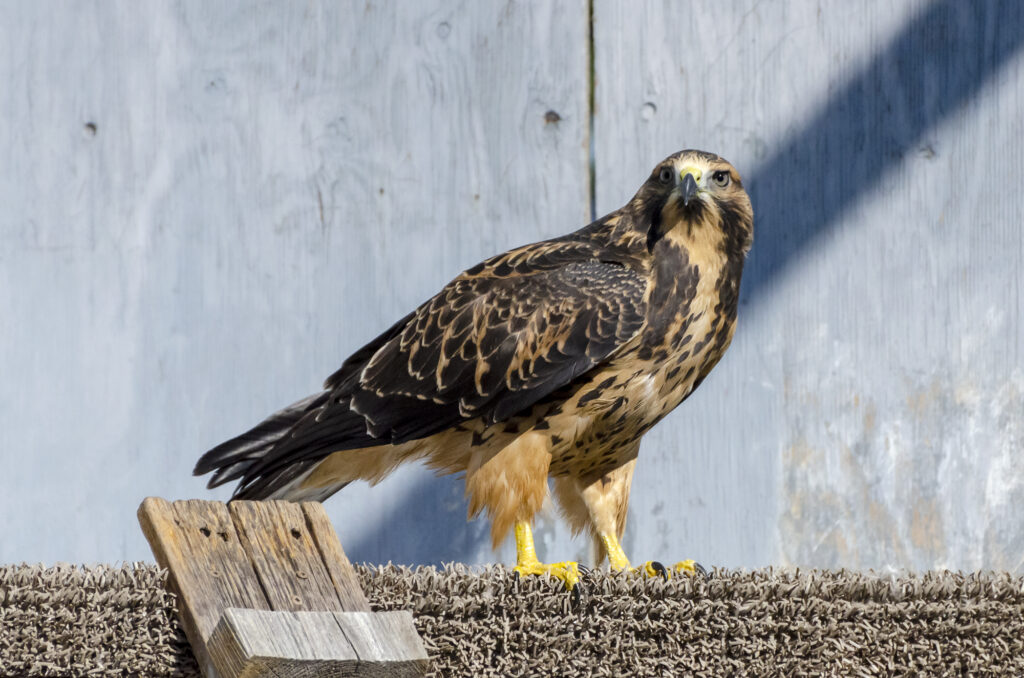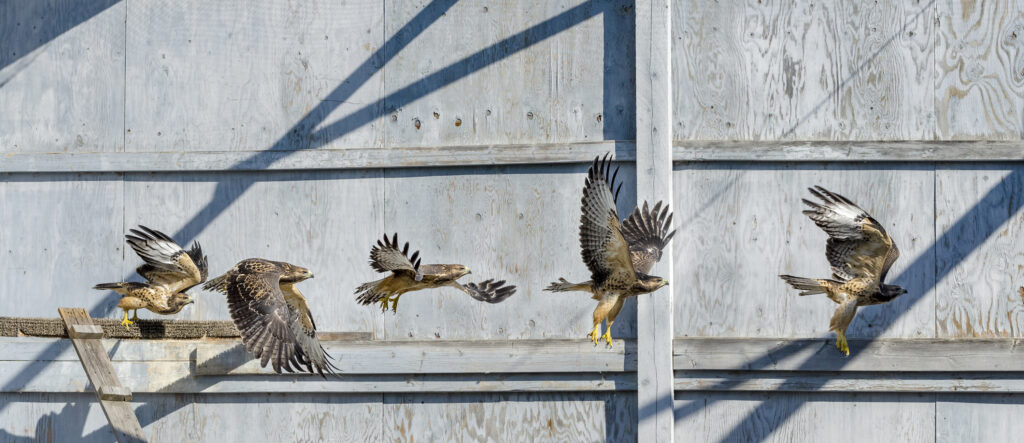
By Julia Gaume, AIWC Volunteer
Identification
Swainson’s hawks (Buteo swainsoni) are large birds of prey called ‘buteos’ which are essentially large hawks. These hawks are named after William Swainson, a British naturalist and artist who specialized in nature illustrations and written work. Although Swainson’s hawks can have variable colour patterns, they typically have some combination of light bellies, dark chests and grey or brown backs, rumps and napes of necks. Their diets are made up of a mixture of small mammals (rabbits, squirrels, mice, gophers) and insects and reptiles (grasshoppers, dragonflies, crickets, lizards). These hawks have fondly been referred to as ‘friends to farmers’ as they snack on the creatures which are most detrimental to crops. Their main methods of foraging for prey are running on foot and soaring over open grasslands. Specific to Southern Alberta, Burrowing Owls make up a large part of the hawk’s diet during breeding seasons. They are social hawks, typically travelling in large groups – especially during their migration seasons.
Intercontinental Living
Swainson’s hawks have one of the longest migratory patterns of any known American hawk, reaching over 6,000 miles each way. In the spring and summer months, these hawks spend their time in North America. They can be found in grasslands, prairies and open farm land along the West Coast and Great Plains.
When fall comes around, Swainson’s hawks make the long travel down towards South America where they spend their autumns and winters in either South America (Argentina, Uruguay, Bolivia), Mexico and along the pacific coast of Central America (Columbia, Guatemala, Nicaragua).
In terms of locations for breeding, Swainson’s hawks do approximately 6% of their breeding in Mexico, 20% in Canada and the majority 73% in the United States.
Being social raptors, Swainson’s hawks migrate in flocks called ‘kettles’ which can reach up to tens of thousands of birds.
Protective Nature
Swainson’s hawks are believed to be monogamous and they return to their same nesting sites year after year. Being so family oriented, they are fierce protectors of both their nests and the baby hawks, ‘eyas’, that are within them. These hawks are known to ‘dive bomb’ anyone and anything who they see as potential threats to their family. Although a Swainson’s hawk may create a nest in our yard, their nest is theirs and they will try their best to protect their young at the expensive of any other animals or humans who come near.
Major Causes of Injury
Swainson’s hawks, like many other birds, have many deaths per year attributed to collisions with vehicles and electrocution on power lines.
Their population size is also negatively impacted through habitat loss; the conversion of open fields to agricultural fields removes their area for nesting sites. Specifically, in Argentina where many Swainson’s hawks spend their winters, the conversion of pastureland to soy bean fields have dramatically minimized the areas in which these hawks can spend and create nests for half of the year.
Pesticides also pose a threat of both injury and death for Swainson’s hawks. Since these birds are commonly found in farming areas, pesticides that farmers use in order to keep harmful insects from destroying their crops can be extremely harmful. Luckily, pesticides that have been proven to cause mass deaths of Swainson’s hawks (and many other bird species) have been banned in multiple countries that the hawks call home.

How Can We Help?
In terms of conservation, Swainson’s hawks are at low risk as their population numbers have remained relatively stable since their initial identification. Although this bird species has had negative fluctuations, before shooting hawks and other native bird species and using known harmful pesticides became illegal, their numbers have bounced back. The key to maintaining Swainson’s hawk population sizes and helping them thrive are centered around trying our best to not intervene with their native habitats.
If there is a Swainson’s hawk nest in your yard, try to avoid the area all together. If that is not possible, try to block off the space to avoid becoming a potential threat in the hawk’s eyes. By doing this, you will be limiting the potential harm for both you, others and any pets that frequent the area while simultaneously letting the hawks live peacefully.
If you are a farmer or live in grasslands, prairies or open farm land where Swainson’s hawks are present, avoiding using harmful pesticides can immensely help the survival of these raptors.
If you are individually, or as part of a company, looking to convert open land for agribusiness operations, try to evaluate if Swainson’s hawks or other native bird species will be negatively impacted or if their habitat or prey will be removed.
By respecting Swainson’s hawks and their nest, we are able to live together cohesively and peacefully.
References
- “Stampede Goers Asked to Stay Hawk-Eyed for Dive Bombing Bird | CBC News.” CBCnews. CBC/Radio Canada, July 14, 2016. https://www.cbc.ca/news/canada/calgary/hawk-stampede-dive-bomb-1.3678393.
- “Swainson’s Hawk – Ebird.” Accessed November 15, 2022. https://ebird.org/species/swahaw/.
- “Swainson’s Hawk.” BirdWeb. Accessed November 15, 2022. https://birdweb.org/birdweb/bird/swainsons_hawk.
- “Swainson’s Hawk Range Map, All about Birds, Cornell Lab of Ornithology.” , All About Birds, Cornell Lab of Ornithology. Accessed November 15, 2022. https://www.allaboutbirds.org/guide/Swainsons_Hawk/maps-range.
- Wales, Melissa, Leslie Pernas-Giz, Kathy Wilkinson, Nancy VanCott, Deb Winter, Dr. Lawrence Olsen, and Joan Hedgpeth. “Welcome to the New BWD.” BWD Magazine. Accessed November 15, 2022. https://www.birdwatchersdigest.com/bwdsite/learn/identification/diurnal-daytime-raptors/swainsons-hawk.php.
- “William John Swainson: Google Pays Tribute to Nature’s Illustrator | @Grrlscientist.” The Guardian. Guardian News and Media, October 8, 2013. https://www.theguardian.com/science/grrlscientist/2013/oct/08/william-john-swainson-artist-naturalist-birds.


